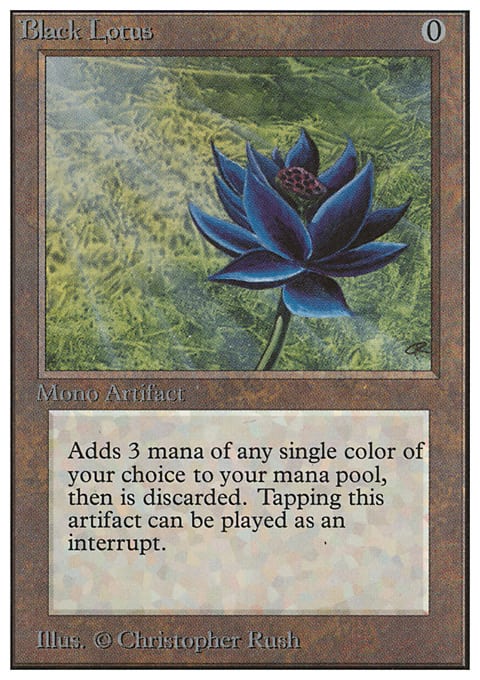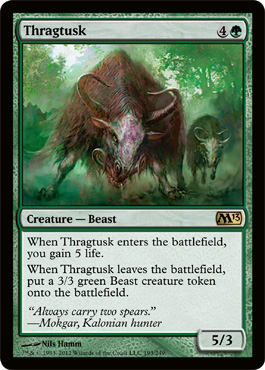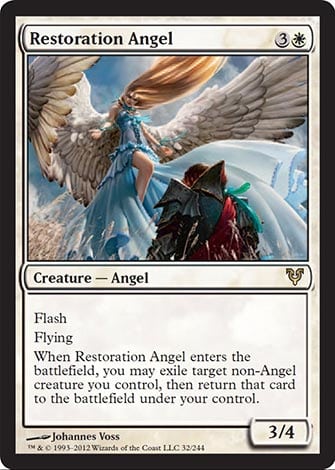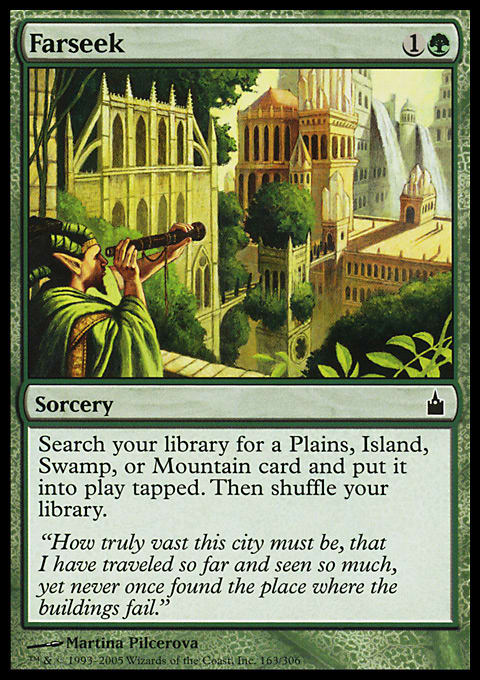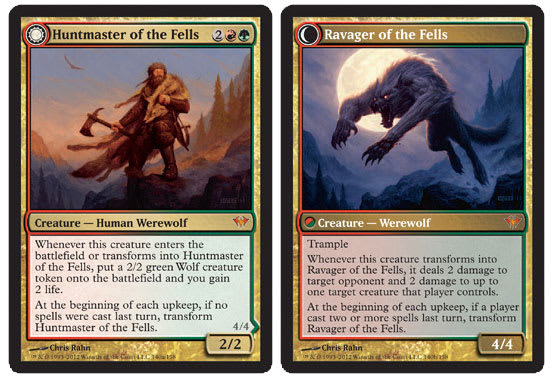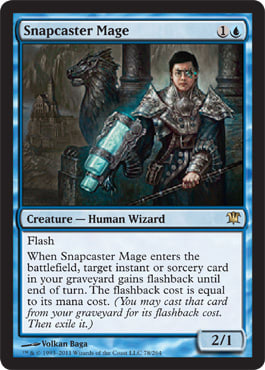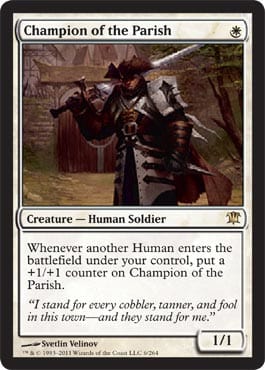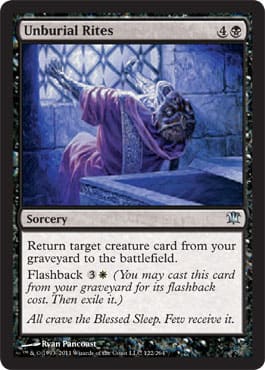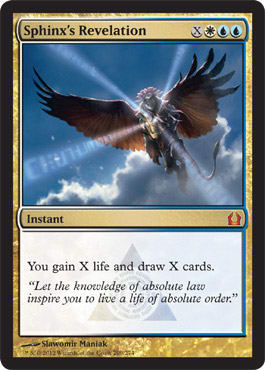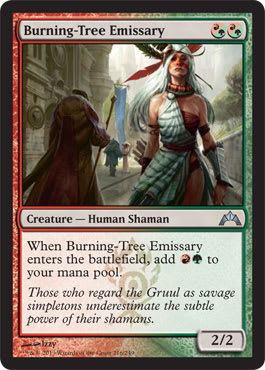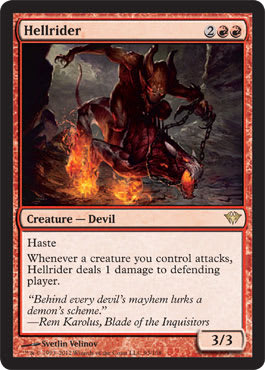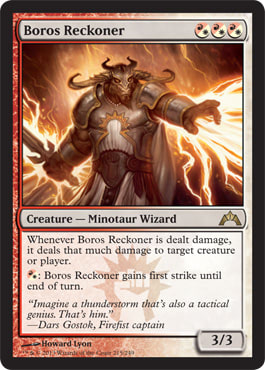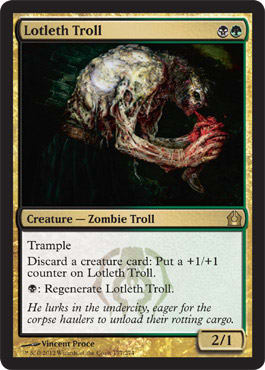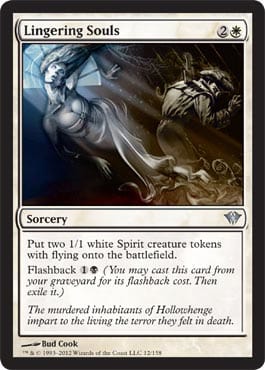So, like any format, Standard has its own power hierarchy, and right now, certain cards really stand out as dominant forces in the metagame and in the format in general. These cards are notable for their high power levels and for the frequency that they serve as cornerstones of the most powerful decks in the format. These are the New Power Nine. Understanding what these cards have in common and what makes them so special can help us recognize what cards will be powerful in new sets and can help us design stronger decks using the current sets.
Thragtusk
Why It Rocks: A 5/3 for 5 mana is slightly undersized, a typical generic 5-drop being around a 5/4 like Golgari Longlegs and Fire Elemental or a 5/5 like Hollowhenge Beast. Of course, Thragtusk’s multiple abilities more than compensate. If it just gave you 5 life when it came into play, it would be a staple sideboard card and main-deck-worthy in many metagames. The fact that it also gives you a 3/3 token when it leaves play makes it fantastic even in matchups in which gaining life isn’t important. You have a package that gives you 5 life and two blockers against beatdown for one card. You also have a card that’s great against control because the opponent usually has to use multiple cards to deal with it.
Where You Find It: Not only does every deck that has green mana and regularly makes it to 5 mana usually run it, but many decks add green specifically to give them access to this game changer. Half the Top 8 at Pro Tour: Gatecrash main-decked at least one Thragtusk, and half of the Top 8 at Grand Prix: Quebec City also included them. Naya midrange, Jund midrange/control, Bant control, and more recently Junk midrange are among the popular decks featuring it currently.
What It Goes With: Thragtusk has many friends. Best known for comboing with Restoration Angel, it also works well with Orzhov Charm and the little-used Conjurer's Closet. Thraggy also goes well with mass removal such as Supreme Verdict—when you gain 5 life and put a 5/3 into play, your opponent is forced to up his commitment to the board, which sets up your mass removal. When the dust settles, you still have a 3/3.
Restoration Angel
Why It Rocks: A 3/4 flyer would be decent even without other abilities, as a generic 4-drop flyer usually comes in around 3/2, such as Assault Griffin or Moon Heron. A 4-drop flyer with flash might be a 2/3—such as Nephalia Seakite—or a 2/2—such as Hollowhenge Spirit since it has another ability—but how about this deal? A 3/4 flyer for 4 mana with flash and you get to momentarily exile one of your other creatures. The size is a critical part of the appeal. Once you make it to 4 mana, it becomes risky for most creatures to attack, because at 3/4, you can flash in your Angel before blockers and take out an attacker without losing your Angel. Add in the fact that you can save a creature from removal or reset a creature’s 187 ability (enters-the-battlefield ability), and you have a thoroughly busted card.
Where You Find It: At 4 mana, the Angel fits in all deck types—as the top of the curve of an aggressive deck or in the middle of the curve for a midrange or control deck. Five of the Top 8 PT decks ran Restoration Angel. Esper control, R/W/U control, The Aristocrats, Bant control, Naya midrange, Selesnya aggro/midrange, and various Junk decks all use this beauty.
What It Goes With: The power level of Restoration Angel goes way down if you don’t have other creatures in play for it to protect or reset with its exile ability. Its power level goes way up when the rest of your deck includes many powerful 187 creatures, such as Thragtusk, Snapcaster Mage, Huntmaster of the Fells, Augur of Bolas, Centaur Healer, and Borderland Ranger. It’s also useful for resetting the pairings of soulbond creatures such as Silverblade Paladin.
Farseek
Why It Rocks: Sure Farseek can’t singlehandedly win you a game as Thragtusk can, but neither could Demonic Tutor or Time Walk, and that didn’t stop them from being busted. Anytime a card lets you cheaply break one of the basic rules of the game (take one turn at a time, draw one card per turn, play one land per turn, etc.), you need to give it some consideration. Not only does this card let you cheaply ramp your mana without forcing you to lean on fragile mana creatures, but it does amazing color-fixing in the current Standard environment. Thanks to dual lands that count as Mountains, Forests, Swamps, Plains and/or Islands, you can search for two colors of mana at once with Farseek.
Where You Find It: Not surprisingly, three-color decks are hot right now. Any midrange or control deck with more than one color that features green runs this card. You’ll see it in Jund, in Bant, in Naya, and in four-color Reanimator decks. It showed up in three of the Top 8 decks from the PT and four of the Top 8 at the GP.
What It Goes With: Green mana. If you’re playing with enough green mana to cast it on turn two and you can afford to spend turn two playing it from a tempo perspective, this card might belong in your deck. If those things apply and you’re playing three or more colors, Farseek definitely goes with your deck. It’s nice with mass removal because it helps ramp you to the mana to cast your mass-removal spell without putting a creature into play and without making your opponent suspicious because you didn’t play a creature that turn.
Huntmaster of the Fells
Why It Rocks: Just making a pair of 2/2s for 4 mana would be decent. Also gaining 2 life makes it a good card. The ability to keep transforming it for damage, more life, and more Wolves is fantastic. Your opponent kind of wants to transform it to make it smaller once you’ve made it big, but then, you make another Wolf and gain 2 more life, and you can just transform it again. Against beatdown, it’s great—you get two blockers immediately and gain life, and if it survives, you can even start picking off the opponent’s small creatures. Against control, you have two creatures for the opponent to deal with, and it forces the player to play spells on his turn if he doesn’t want it to transform right away.
Where You Find It: Huntmaster was in two of the PT Top 8 decks and five of the GP Top 8 decks. A staple in Jund midrange/control, it also appears in Naya midrange, Naya Humans, and Human Reanimator.
What It Goes With: It combines nicely with anything that likes Humans, tokens, Werewolves or Wolves, and/or 187 creatures. Consider trying it with Champion of the Parish, Mayor of Avabruck, Angel of Glory's Rise, Intangible Virtue, Immerwolf, and/ or Restoration Angel.
Snapcaster Mage
Why It Rocks: A 2/1 is right on curve for a 2-drop, and having flash makes him almost Constructed-worthy right away. Of course, the real prize here is his 187 ability. Being able to select any one of the spells in your graveyard to reuse—in addition to making a 2/1 at instant speed—is a major prize for any decks with a lot of instants and sorceries.
Where You Find It: If you have blue mana, it’s really just about how many instants and/or sorceries you’re playing. He was included in three of the Top 8 decks at PT: Gatecrash. He’s most commonly found in Esper control and R/W/U control. Thanks to changes in development at Wizards, creatures are becoming better than spells in most cases (as evidenced by comparing this list to the original Power Nine), so most decks aren’t running enough noncreature spells to make him worthwhile despite his extremely high power level.
What It Goes With: He’s great with cheap instants such as Thought Scour, Unsummon, and Azorius Charm. He also pairs nicely with Restoration Angel thanks to his 187 ability.
Champion of the Parish
Why It Rocks: Almost all of the best aggressive 1-drops in Standard right now benefit from +1/+1 counters: Experiment One, Rakdos Cackler, Stromkirk Noble, and Champion of the Parish. The Champion just happens to be the one that can attack on turn two for 3 or even more without an enchantment, an Equipment, or a pump spell. You only have to invest 1 mana in him, yet in the right deck, his size can stay ahead of the curve on every turn.
Where You Find It: Like Snapcaster Mage, his power level can vary widely depending on the rest of the cards in your deck, so he appears in fewer archetypes, but he makes up for it by being the star of those decks. He was arguably the best card in the deck that won the PT, and he appeared in three of the Top 8 decks from the GP. He’s featured in Zoo, The Aristocrats, Naya Humans, and mono-white Humans.
What It Goes With: Humans—the more, the better. He’s especially good with Burning-Tree Emissary and Gather the Townsfolk because of their abilities to make him into a 3/3 on turn two.
Unburial Rites
Why It Rocks: It’s no accident that this card is the cornerstone of the only powerful combo deck in the format. Even if you just played it straight, you get to put the best creature in your graveyard directly into play . . . twice. Yet, why play fair? In the right deck, Unburial Rites can be used to put a ludicrously expensive creature into play for only 4 or 5 mana. Thanks to flashback, you don’t even have to draw the Rites; you can just mill it into your graveyard.
Where You Find It: Given the power level and specific (and fairly unique in Standard) function of this card, it pretty much only appears in decks that are designed around it. This basically means any of the various Reanimator decks. Reanimator decks finished fifth and ninth at the GP.
What It Goes With: The Rites work with expensive creatures and ways to put them into your graveyard quickly. Unburial Rites is often found in collaboration with Faithless Looting, Grisly Salvage, Mulch, Angel of Glory's Rise, Craterhoof Behemoth, and/or Angel of Serenity.
Sphinx's Revelation
Why It Rocks: Blue control decks love/need to draw cards. Unfortunately, it’s usually hard to find time to spend much mana doing so because of the loss of tempo against an aggressive opponent and not wanting to tap out on your turn against anyone. Revelation solves this by not only allowing you to draw multiple cards at instant speed, but by gaining you life while you’re at it! This card is so back-breaking to play against that I usually feel the game is pretty much over if my opponent casts it for at least 3 during the end of my turn. Turning one card into three or more cards and 3 or more life is a huge swing in almost any matchup.
Where You Find It: Any deck that’s planning on making it to more than 4 mana and uses both white and blue mana. This includes Esper control, R/W/U control, and Bant control. Half of the Top 8 decks at PT: Gatecrash were running it.
What It Goes With: Cards that help you stall the game—if you can stay alive long enough to launch one of these for 4 or 5, you’re probably going to win almost any matchup. It goes especially well with instants and flash creatures because you can sit back and see if you need to cast another instant on a given turn or if the tempo of the game gives you an opening to launch a Revelation. It’s also nice to be playing mass removal—you can say “go” without adding anything to the board, and if your opponent adds pressure, you gain life and draw into mass removal. If your opponent doesn’t add pressure, you gain life and draw cards, and he’s even further behind. Plus, Revelation helps you reload your hand after wiping out the creatures that were on the board.
Burning-Tree Emissary
Why It Rocks: Tempo, tempo, tempo. This is essentially a free 2/2 Human that you just aren’t allowed to play until turn two, and you can only play it in decks with red and/or green mana. In addition, it can even be used to help you color-fix in the right deck. Since this is a Gatecrash card, we’re only just beginning to find all the ways to abuse it. The possibilities seem endless: Imagine playing a Restoration Angel after your opponent declares attackers on turn four; you Flicker your Emissary and then use the mana from its return to cast a Searing Spear or a Giant Growth.
Where You Find It: The Emissary was in three of the Top 8 decks from the GP. It’s used in red aggro, Gruul aggro, Jund aggro, Human Reanimator, Zoo, and Naya Humans.
What It Goes With: It combos nicely with Champion of the Parish, Lightning Mauler, Angel of Glory's Rise, Restoration Angel, and just about anything you can cast for a ![]() and a
and a ![]() . Probably the best I’ve seen it function was when it was played on turn two with a Champion of the Parish in play and its mana was used to cast a Lightning Mauler. It was then paired, allowing the player to attack with all three creatures for 7 damage on turn two.
. Probably the best I’ve seen it function was when it was played on turn two with a Champion of the Parish in play and its mana was used to cast a Lightning Mauler. It was then paired, allowing the player to attack with all three creatures for 7 damage on turn two.
Honorable Mentions
As you can see, the new power in Magic has shifted from artifacts, instants, and sorceries to mainly creatures, and that’s the way Wizards likes it. Your challenge is to find ways to synergize these cards and stuff as many of them as possible into a deck. Alternatively, you can take the even harder challenge to try to find an overlooked card that, when used properly, can rival these cards in power. The biggest difference between these cards and the Vintage power cards is that Vintage power is good in any deck, and these cards need you to support them with other cards that specifically synergize with them. We used to build fifty-one card decks and then add the Power Nine. Now we just build decks.
















